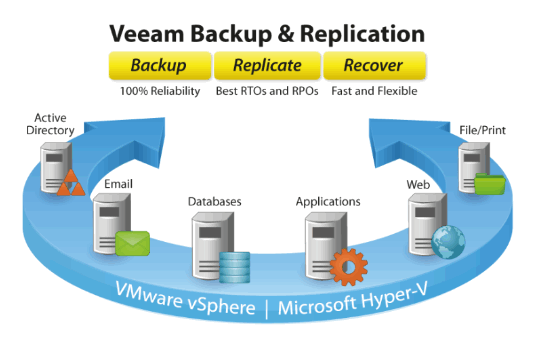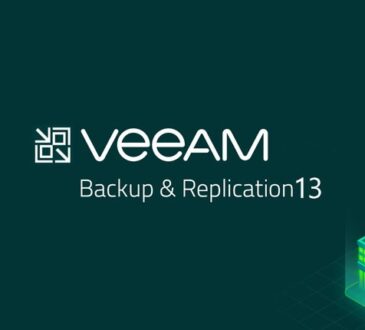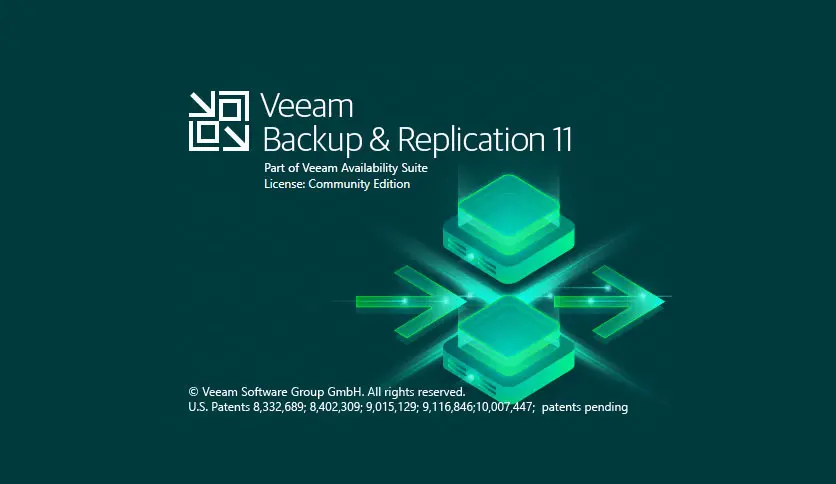
Overview of Backup System
When it comes to data protection, Veeam Backup & Replication offers several backup methods tailored to different needs and environments. Understanding these methods is crucial for implementing an effective backup strategy. Here’s a detailed discussion of the main types of backups available in Veeam. Veeam Backup & Replication offers several types of backups to meet different business needs, each designed to optimize storage efficiency, recovery speed, and data protection. In this blog post, we’ll discuss the main types of backups available in Veeam, explaining how they work and their key benefits.
Table of Contents
Full Backup
A full backup is one of the most fundamental types of backup in any data protection strategy, and Veeam Backup & Replication makes full use of this technique. In Veeam, a full backup creates a complete copy of the entire selected data set, including operating system files, applications, and user data. This approach ensures that all the data from a virtual machine (VM) or physical server is captured and stored in a single backup file, ready for recovery when needed.
Let’s take a closer look at the features, advantages, and best use cases of a full back up in Veeam.
A full backup captures all data associated with the protected workload at a specific point in time. Veeam uses this method as the foundation of its backup strategies, as it provides a complete snapshot of the data, making it easy to restore an entire system or individual files if necessary. In Veeam, the full backup is usually the first backup job that is run, establishing the base for future backups, whether incremental or differential.
Key Features of a Full Backup
Complete Data Capture
A full backup in Veeam copies all data, including system files, application data, and user files, ensuring that everything is backed up. This makes it easier to restore the entire system from a single backup file in case of a disaster.
Independent Backup File
Since a full backup contains all the data, it doesn’t rely on any previous backups for recovery. This makes the restoration process straightforward and ensures data integrity.
Larger Storage Requirement
Full backups tend to take up more storage space because they include all data, not just the changes. However, this also simplifies recovery as you don’t need to piece together multiple backup files.
Longer Backup Time
Full backups generally take more time to complete compared to incremental or differential backups. This is because every piece of data is copied during the backup job.
Ideal for Initial Backups
The full backup is typically the first backup performed when setting up Veeam Backup & Replication. It serves as the baseline for other backup types like incremental or synthetic full backups, which are more storage efficient.
Click to download Veeam Backup & Replication 12
Advantages of Full Backups in Veeam
Faster Recovery
Since the full backup contains all the data, recovery times are faster. Veeam doesn’t need to rely on additional backup chains (incremental or differential backups) to restore data.
High Data Integrity
Full backups offer a high level of data integrity. The backup file is self-contained, making it less prone to corruption or dependency issues compared to incremental backups.
Simplified Management
With a full back up, you can easily manage and restore data, knowing that all the information you need is in one place. There’s no need to worry about merging multiple backup files or retrieving incremental data.
Disadvantages of Full Backups in Veeam
Large Storage Requirement
Full backups require significantly more storage than other types of backups, like incremental or differential. This can increase costs and the need for more disk space.
Longer Backup Windows
Full backups take more time to complete as all data is copied, not just the changed data. In environments with limited backup windows, this may cause performance issues.
Impact on Performance
Running frequent full backups can impact production systems as they consume more resources (CPU, network bandwidth, and storage) during the backup process.
Incremental Backup
Incremental backups are an essential part of a modern backup strategy, offering significant advantages in terms of efficiency, storage utilization, and speed. In Veeam Backup & Replication, incremental backups are one of the core backup methods used to optimize data protection processes, especially for large environments where frequent backups are needed.
An incremental backup only backs up data that has changed since the last backup, whether it was a full backup or another incremental backup. Unlike full backups, which capture the entire dataset, incremental backups only copy new or modified data. This reduces both backup time and storage consumption, making it a popular choice for daily or frequent backups.
How Incremental Backup Works
Initial Full Backup
The first time you create a backup job in Veeam, a full backup is taken. This full backup contains all the data from the virtual machines (VMs), applications, or servers you’re protecting.
Subsequent Incremental Backups
Once the initial full backup is complete, Veeam begins to perform incremental backups based on the schedule you’ve configured. Each incremental backup only includes data that has changed since the last backup (full or incremental). Veeam uses change block tracking (CBT) in VMware or Hyper-V environments to identify which data blocks have been modified, speeding up the process.
Backup Chain
Incremental backups are dependent on the full backup and any previous incremental backups. To restore the most recent version of your data, Veeam needs to apply the full backup and then sequentially apply all incremental backups in the chain. The longer the chain of incremental backups, the more time it takes to restore the data.
Retention and Backup Merging
To avoid an overly long chain of incremental backups (which can slow down recovery), Veeam allows you to configure retention policies. These policies can automatically merge older incremental backups with the full backup to keep the chain manageable.
Benefits of Incremental Backup in Veeam
Efficient Storage Usage
Incremental backups require significantly less storage space compared to full backups because they only capture changes, not the entire dataset. This is particularly useful for environments with limited storage capacity or those handling large amounts of data.
Faster Backup Process
Since Veeam only backs up changed data, incremental backups are much faster than full backups. This is crucial for minimizing the impact on production systems during the backup window, especially when frequent backups are needed.
Reduced Network Bandwidth Usage
Incremental backups minimize the amount of data transferred over the network. In distributed environments or when backing up to a cloud repository, this helps reduce bandwidth consumption and backup time.
Granular Restore Points
Incremental backups provide a fine level of granularity, meaning that you can restore your data to the most recent backup point with minimal loss of data. This is especially valuable in environments where data changes frequently and requires precise recovery.
Incremental Backup is further divided into 3 different types.
Forward Incremental Backup
In this mode, Veeam starts with a full backup, followed by a series of incremental backups. Over time, the chain of incremental backups grows longer. To keep the backup chain short and manageable, Veeam allows periodic creation of synthetic or active full backups to “reset” the chain.
Forever Forward Incremental Backup
In this mode, after the initial full backup, only incremental backups are created. Old backups are automatically merged with the full backup as new restore points are created. This mode is ideal for environments with limited storage, as it minimizes the number of full backups required.
Reverse Incremental Backup
In this mode, Veeam creates restore points by modifying the previous backup files to reflect changes since the last backup. The newest restore point is always a full backup, and previous restore points are stored as reverse increments. This provides fast restore times but can be slower to process compared to forward incremental.
Differential Backup
A differential backup captures all changes made to the data since the last full backup. It does not depend on incremental backups; instead, it stores every modification or addition since the most recent full backup. As a result, the size of differential backups grows over time until the next full backup is created.
For example, if a full backup was taken on Monday, and differential backups were taken daily, the differential backup on Tuesday would only contain changes made since Monday’s full backup. On Wednesday, the differential backup would contain all changes made since Monday, not just changes made on Tuesday.
Veeam’s differential backup mechanism captures data blocks that have changed since the last full backup. This means that the more time passes between full backups, the larger the differential backups will become, as they will continue to accumulate all the changes since that initial full backup.
In the Veeam Backup & Replication setup:
Full Backup: The first step is to create a full backup, which serves as the baseline for all future differential backups.
Differential Backup: Every time a differential backup is run, it compares the current state of the data to the last full backup and saves any changes. This continues until another full backup is created.
Key Features of Differential Backups in Veeam
Efficiency: Differential backups are more storage-efficient than full backups but less so compared to incremental backups. They only store changes since the last full backup, reducing the need to copy all data with each backup cycle.
Simplified Restoration: One of the biggest advantages of differential backups over incremental backups is that restoration is simpler. During recovery, Veeam only needs the last full backup and the latest differential backup to restore the entire dataset. There is no need to go through a chain of incremental backups, which can sometimes cause delays or increase the risk of errors.
Growing Size: A key consideration with differential backups is that their size grows with each new backup until the next full backup is taken. As the period between full backups increases, the differential backup stores more changes, leading to larger backup files.
Advantages of Using Differential Backups
Faster Recovery Time: Since only the last full backup and the most recent differential backup are required for restoration, differential backups generally offer faster recovery times than incremental backups. This makes it a good option when minimizing Recovery Time Objective (RTO) is a priority.
Moderate Storage Usage: While not as efficient as incremental backups in terms of storage, differential backups strike a balance between space-saving and recovery efficiency. They require less storage than doing a full backup every time but more than incremental backups.
Less Complex Recovery: Restoring from differential backups is simpler compared to incremental backups, which need all previous backups in the chain. This makes differential backups ideal for environments where reliability and speed of recovery are important.
Disadvantages of Differential Backups
Increasing Backup Size Over Time: The primary drawback of differential backups is that they grow in size as time passes since the last full backup. This can eventually slow down backup times and require more storage space.
Storage and Bandwidth Concerns: While differential backups are more efficient than full backups, they are still larger than incremental backups. This means they can consume more storage and network bandwidth over time, especially in environments with frequent changes.
Synthetic Full Backup
A Synthetic Full Backup is a method that consolidates existing backup data into a new full backup file without retrieving data from the source virtual machine (VM). Instead of pulling data directly from the production environment, Veeam synthesizes a full backup using previously stored incremental backups and the last full backup available in the backup repository.
Advantages of Synthetic Full Backups
Reduced Network Load: Since synthetic full backups do not require data retrieval from production storage, they significantly reduce network bandwidth consumption. This is particularly beneficial in environments with limited bandwidth or during peak operational hours.
Lower Impact on Production Systems: The synthesis occurs on the backup repository rather than on production servers, minimizing I/O load on live systems. This helps maintain performance levels for users and applications.
Efficient Storage Management: Synthetic full backups reset the backup chain, allowing subsequent incremental backups to reference the latest synthetic full as their starting point. This can lead to more efficient use of storage over time.
Flexibility in Scheduling: Organizations can schedule synthetic full backups at regular intervals (e.g., weekly) to ensure they have up-to-date restore points without the overhead of frequent active full backups.
Disadvantages of Synthetic Full Backups
While Synthetic Full Backups in Veeam offer several advantages, such as reduced network load and lower impact on production systems, they also come with notable disadvantages. Understanding these drawbacks is essential for organizations considering this backup method. Here are the main disadvantages of synthetic full backup
Increased Storage Requirements
Synthetic full backups can lead to higher storage consumption. Each synthetic full backup retains all previous incremental backups, which means that the backup repository can become cluttered with multiple versions of data. This duplication can result in significant storage usage, especially if retention policies are not carefully managed.
Longer Backup Creation Times
Although synthetic full backups do not require data to be pulled from the production environment, the process of merging incremental backups into a new full backup can be time-consuming. This is particularly true for larger datasets, where the synthesis process may take longer than performing an active full backup. The time required for this operation can impact backup windows and overall system performance.
Potential for Data Loss During Merging
During the synthesis process, there is a risk of data loss if a failure occurs. If an error happens while merging incremental backups into a synthetic full backup, it may result in incomplete or corrupted backup files. This risk necessitates careful monitoring and potentially additional safeguards during the backup process.
Complexity in Restore Process
While synthetic full backups simplify the restore process by presenting a single backup file, they can complicate the overall management of restore points. If multiple synthetic full backups are created over time, it can become challenging to track which version contains specific changes or data points, especially if granular recovery is needed.
Performance Impact on Backup Repositories
Creating synthetic full backups can place a higher I/O load on backup repositories compared to active full backups. The merging process requires reading from multiple incremental files and writing to create a new full backup, which can strain storage resources and potentially lead to performance degradation during peak usage times.
Retention Policy Challenges
Using synthetic full backups may inadvertently lead to unintentional expiration of data due to retention policies that are defined by the number of full backup cycles. For example, if synthetic full backups are run immediately after a standard full backup, they may not consolidate any data effectively, leading to unnecessary consumption of storage resources without providing additional value.
Mirror Backup in Veeam
A Mirror Backup in Veeam refers to the process of creating an exact copy of backup data from one location to another. This is achieved through the Backup Copy Job (BCJ) feature, which allows users to create multiple instances of the same backup data across different storage locations or repositories.With the introduction of Veeam’s immediate copy (mirroring) feature in version 10, mirror backups can now be set up to copy every restore point as soon as it appears in the source backup repository. This contrasts with traditional periodic copies that only replicate the latest available restore point at specified intervals.
When a new backup is created in the primary repository, the immediate copy job triggers automatically to replicate this backup to a secondary location. This process ensures that every restore point is available almost in real-time, enhancing data availability and minimizing potential data loss.
The mirror backup feature can also process transaction log backups for databases like SQL and Oracle, ensuring that all changes are captured and replicated efficiently. It supports Veeam Enterprise Plugin data for applications like SAP HANA and Oracle RMAN.
Advantages of Mirror Backup in Veeam
Mirror Backup is a powerful feature in Veeam Backup & Replication that allows organizations to create real-time copies of backup data across different locations. This method enhances data redundancy and availability, making it a popular choice for businesses seeking robust data protection solutions.
Real-Time Data Availability
Mirror backups allow for immediate copying of restore points as soon as they are created. This ensures that the most recent backup data is always available, significantly improving recovery point objectives (RPO) and minimizing potential data loss.
Enhanced Redundancy
By maintaining copies of backup data in multiple locations, organizations can safeguard against hardware failures, disasters, or cyber threats. This redundancy is critical for ensuring business continuity.
Efficient Disaster Recovery
In the event of a disaster, having mirror backups readily available in a secondary location enables quick recovery processes. Organizations can restore operations faster, reducing downtime and associated costs.
Flexibility in Backup Management
Veeam’s mirror backup feature can be configured to suit specific organizational needs, allowing for both immediate and periodic copy options. This flexibility helps organizations tailor their backup strategies based on resource availability and recovery requirements.
Transaction Log Processing
The immediate copy feature can process transaction log backups for databases like SQL and Oracle, ensuring that all changes are captured and replicated efficiently. This capability is particularly beneficial for businesses relying on critical applications that require up-to-date data.
Disadvantages of Mirror Backup
Increased Storage Costs
Maintaining multiple copies of backup data can lead to higher storage consumption. Organizations must evaluate their storage capacity and budget accordingly to accommodate these additional copies.
Network Bandwidth Usage
The immediate copy process may require significant network bandwidth, especially during peak usage times. This could impact other operations if the network infrastructure is not adequately prepared to handle the load.
Management Complexity
While mirror backups provide redundancy, they can also introduce complexity into backup management. Organizations need effective monitoring and management strategies to ensure that all backup copies are functioning correctly and are accessible when needed.
Performance Impact on Backup Repositories
Creating mirror backups can place a higher I/O load on backup repositories compared to other methods. The process of copying data immediately after it is backed up may strain storage resources, potentially leading to performance degradation during peak usage times.
Retention Policy Challenges
Careful consideration must be given to retention policies when using mirror backups. If not managed properly, this method may lead to excessive storage consumption due to multiple backup copies being retained longer than necessary.
- Design






Great explanation.